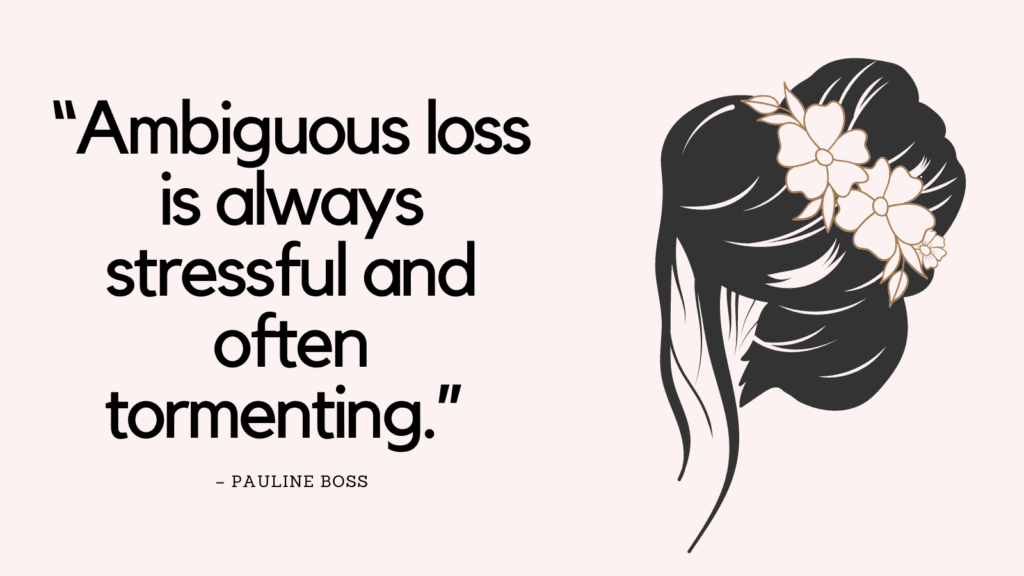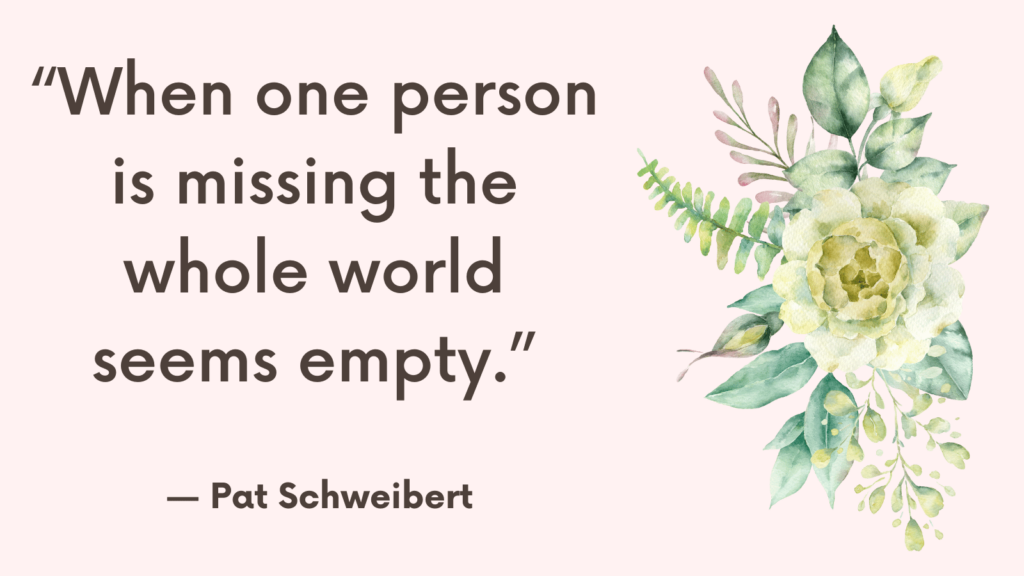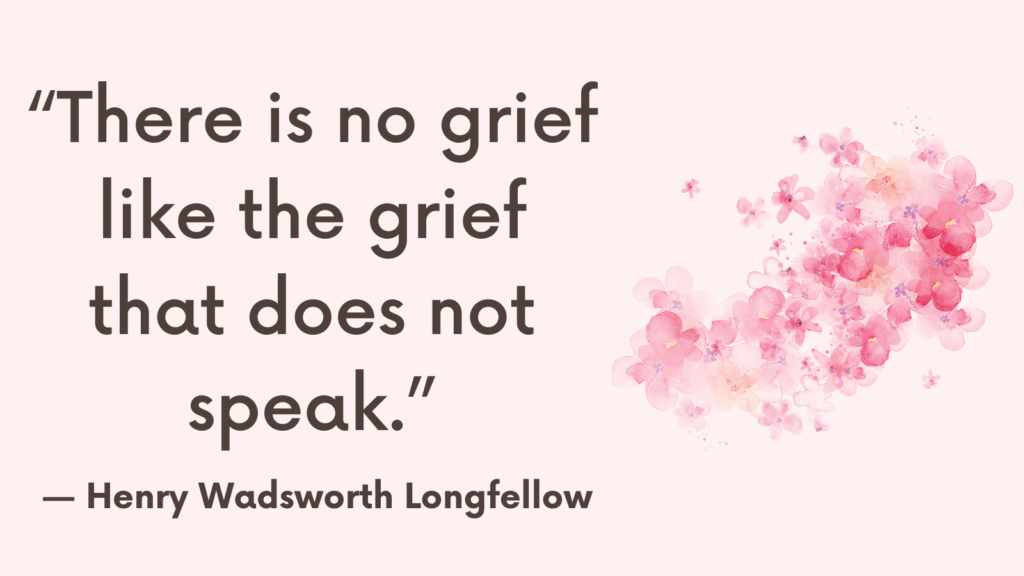Grieving someone who is alive is known as ambiguous grief, or unconventional grief, or frozen grief.
It was family therapist Pauline Boss, PhD, who first coined the term “ambiguous loss” and published her book by the same name.
What Is Ambiguous Grief?
Ambiguous grief is caused by a loss that occurs without a likelihood of reaching emotional closure or a clear understanding of what happened.
This occurs when the love one is:
(1) perceived as present when they are physically gone (e.g., disappearance of a family member, a soldier missing in action, Being adopted and not knowing he identity or whereabouts of the biological parents), or
(2) they are perceived as gone when they are physically present (e.g., a family member being physically alive but in a state of cognitive decline due to Alzheimer’s disease or dementia, etc.)
The person dealing with ambiguous grief is left searching for answers and living in doubt.
They may find themselves asking, “Am I still married to a spouse who doesn’t remember me?” or, “Am I still a parent to my alienated child?”
It can be difficult to grieve a halted loss and move on. This usually complicates and delays the process of grieving.
The greater the ambiguity surrounding the loss, the greater it is the distress.
Read: Grief Is A Journey Not A Destination (& Other 12 Grief Lessons No One Talks About)
Why Is It Difficult To Grieve Someone Who Is Still Alive?
Because the loss is confusing, people usually respond with absolutes.
They either act as if the person is completely gone, or they deny that anything has changed.
Both reactions can be distressing, preventing us from moving on.
Even when we react as if the person is completely gone, the absence of the symbolic, supportive rituals that usually come with a clear loss (such as a funeral) prevents us from experiencing the validation we need to move on.
Moreover, ambiguous loss is a loss that goes on and on and leaves us emotionally and physically drained.
Mixed Emotions and Ambivalence
Grieving someone who is still alive involves mixed feelings and thoughts.
Someone who’s grieving a family member who’s terminally ill may dread their death but also hope for an end to the waiting.
They may also feel anger at the person keeping them in the uncertainty, but also feel guilt for having such thoughts.
These conflicted feelings can become so overwhelming.
Tips to Help With Grieving Someone Who Is Still Alive
#1. Redefine Your Relationship With The Missing Person
Ambiguous loss can make us feel incompetent and clash with our belief that the world is a fair and orderly place.
At some point, you may hit bottom and shift your perception about the person you’re grieving.
This happens when you come to accept that the ambiguous loss is here to stay and learn to cope with uncertainty.
You let go of seeking answers, trying to find the perfect solution or closure.
Instead, you redefine your relationship with the missing person.
For example, someone whose spouse cannot recognize them because of Alzheimer’s disease, may choose not to think of them as a spouse but rather as someone they are caring for.
Redefining the relationship can ease some of the ambiguity around whether or not they’re still married to someone who doesn’t recognize them anymore.
#2. Use Functional Ways of Coping
Grieving someone who is still alive can bring a wide range of conflicted emotions.
This can lead to maladaptations to the ambiguous loss: People may start drinking too much, eating too much, using drugs, and other forms of addictions to cope with these overwhelming feelings and thoughts.
It is important to learn healthier ways of coping as you navigate your way through ambiguous grief, such as:
- Seeking therapy
- Journaling
- Meditating
- Seeking support from safe people
Read More: How To Heal A Grieving Heart? +30 Activities That Will Help You Navigate Grief
Conclusion
Ambiguous grief is one of the most devastating types of grief because of its uncertainty.
An old English nursery rhyme encapsulates the unclear and uncertainty nature of ambiguous grief:
“As I was walking up the stair,
I met a man who was not there.
He was not there again today.
Oh, how I wish he’d go away.”
We long for certainty, so much so that the knowledge of death can be more welcome than living in doubt.
Free Printable Worksheets For Grief (PDF)
References
- Portions of this article were adapted from the book Ambiguous Loss: Learning to Live with Unresolved Grief, © 1999 by Pauline Boss. All rights reserved.
- What Ambiguous Loss Is and How To Deal With It – Cleveland Clinic
- What Is Ambiguous Loss? | Psychcentral.com
- Home | Ambiguous Loss
- Ambiguous loss – Wikipedia
- Ambiguous Grief: Grieving Someone Who Is Still Alive – Whats your Grief
- Speaking of Psychology: Ambiguous loss and the “myth of closure,” with Pauline Boss, PhD (apa.org)
- Ambiguous Grief: The Symptoms and How to Cope | The Healthy
- Managing ambiguous loss and grief | Alzheimer Society of Canada
- Ambiguous loss differs from typical grief—here are tips to deal | Well+Good (wellandgood.com)
- What if There’s No Such Thing as Closure? – The New York Times (nytimes.com)
- Ambiguous Loss | Psychology Today
- Coping with COVID’s emotional toll requires accepting that it has changed us : Shots – Health News : NPR
- Pauline Boss — Navigating Loss Without Closure | The On Being Project



